
|
Sale 80
June Pre Long Beach Sale
| Lot |
Photo |
Description |
Realized |
Lot 386 |
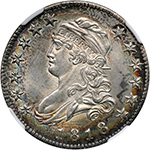 |
1818. NGC graded MS-66+. Light hint of blue and gold tone. This is one of the more difficult Types to obtain in superb condition. The Capped Bust Quarter in the large format was made only in the years 1815, and again in 1818 to 1828, with none minted in 1826. The almost unmatched technical quality of this Gem BU 1818 certainly sets it apart from most. This is a simply gorgeous Gem with lovely toning as mentioned. Both sides are frosty in texture with well centered, sharply defined features and only the lightest striking softness over the highest portions of Liberty's hair curls and the eagle's talons. With no harmful abrasions, this coin is every bit the MS66 "+" premium quality Gem you would expect from the assigned grade. Note as well how few are reported in the NGC census: Pop 2; 2 finer, 1 in 67, 1 in 67 Star .
Design by John Reich. According to the Breen encyclopedia, "John Reich was a German engraver who sold himself into indentured service to reach the USA during the Napoleonic wars. As early as 1801 he sought a post in the Philadelphia Mint, but Chief Engraver Robert Scot was unwilling to tolerate any outsiders, presumably fearing replacement. However, by 1807 Scot's age and health (probably eyesight) were already a source of enough official concern that the Mint authorities began looking for assistant engravers. On April 1, 1807, they hired Reich, at $600 per year (even then a pittance for so demanding a job). Reich's first assignment was indeed a slap at Scot: He was to redesign all denominations."
Reich's new conception for the silver coins was a bold image of Liberty, wearing a "mobcap" ("a round, gathered or pleated cloth, usually linen, bonnet consisting of a caul to cover the hair, a frilled or ruffled brim, and, often, a ribbon band, worn by married women in the Georgian period, when it was called a bonnet" explains the Wikipedia entry). The cap is inscribed with her name. This was for generations misnamed a turban by numismatists who apparently never saw a real one; and even from the beginning it was taken to represent the pilleus or Phrygian liberty cap, whereas Reich actually intended it as a fashionable headdress, somewhat like that on some portraits of Martha Washington. The intermittent mintage of this denomination reflected public preference for Spanish and Mexican 2-real coins, which were legal tender at par though lighter in weight, and half dollars; heavier federal quarters tended to be hoarded, finally many being melted in 1853.
Estimated Value $30,000 - 35,000.
View details and enlarged photos
| Realized
$41,125 |
Lot 387 |
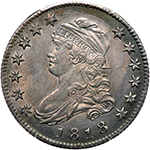 |
1818 Browning-1. PCGS graded MS-63. Well struck with nice even toning. A satiny example in very choice state of preservation. Supple underlying luster is enveloped in pale to medium gray toning originality. A pleasing example of the date, one that is almost completely struck barring a couple of rounded stars, and with sufficient detail in the head, curls, clasp, eagle and shield areas to deserve special mention. The Capped Bust Left type was produced from 1815 to 1828 but not every year, and in relatively small numbers. Scarce in this choice Mint condition.
Ten die marriages are known for 1818, from a mintage of 361,174 coins. This mintage was produced from five obverse and seven reverse dies. On Browning-1, the repunched star 13 and the recut 2 in the denomination help confirm the variety. Scroll ends: below center of upright of D, center of right base of A. Later die state has a crack connecting stars 7 through 10 and a few freckles of die rust along the lower reverse margin, both die crack and freckles noted with this specimen. Pop 26; 71 finer, 44 in 64, 22 in 65, 4 in 66, 1 in 67. (PCGS # 5322) .
Estimated Value $5,500 - 6,000.
View details and enlarged photos
Check results on similar lots
| Realized
$6,756 |
Lot 388 |
 |
1818, 8 over 5 B-1. NGC graded MS-65. Light blue toning. Softly struck on the eagle's neck. Pop 9; 3 finer, 2 in 66, 1 in 67.
Estimated Value $20,000 - 22,000.
View details and enlarged photos
| Realized
$22,913 |
Lot 389 |
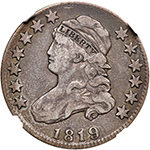 |
1819 Large 9. B-2. NGC graded VF-20. On this variety, the E in UNITED is entered high. Nice old time toning. The coinage of 1819 was accomplished through the use of four die combinations with a total of 144,000 examples produced. Four obverse and three reverse dies were combined for the quarter dollar coinage of 1819.
Estimated Value $350 - 375.
View details and enlarged photos
| Realized
$494 |
Lot 390 |
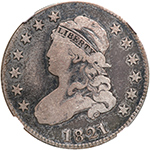 |
1821. NGC graded Good-6. Lightly toned.
Estimated Value $50 - 60.
View details and enlarged photos
| Realized
$141 |
Lot 391 |
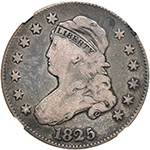 |
1825. NGC graded VG-8. Old time toning.
Estimated Value $70 - 80.
View details and enlarged photos
| Realized
$129 |
Lot 392 |
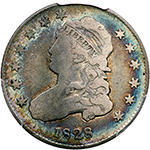 |
1828. 25 over 50¢. Browning-3. PCGS graded Fine-12. Lovely old time blue toning. Only 102,000 struck. The blundered denomination 25/50C reverse die, first used in 1822, makes a return visit on one of the scarcest 1828 varieties. The obverse features a wide date, at least when compared with Browning-4
It appears a non-attentive die engraver thought that he was working on a Half Dollar die, but soon realized his mistake and partially effaced the errant denomination. Nonetheless, the curves of a 5 and 0 are noted within the 25. This same reverse die was used earlier in 1822 on B-2 (PCGS # 5343) .
Estimated Value $700 - 800.
View details and enlarged photos
Check results on similar lots
| Realized
$1,939 |
Lot 393 |
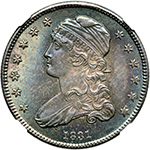 |
1831. Small Letters B-1. NGC graded MS-66+. Lovely blue and golden toning. Along with the delicate colors that grace this, we note satiny, extremely lustrous surfaces. Absolutely gem in all respects; the strike is sharp, the surfaces are essentially devoid of marks of any consequence, and the eye appeal is as expected as the assigned grade. Further, the present coin is the only one in its NGC "+" category (see census below).
Mint Director Samuel Moore laid the cornerstone of the new Mint building ("Second Mint," Juniper and Chestnut Sts.) on July 4, 1829, though not all machinery was to be installed for another 3-1/2 years. On the same day, Moore notified Treasury Secretary Levi Woodbury that coinage of half dimes had begun, embodying several mechanical improvements which he proposed to extend to all other denominations as soon as possible. Notable among these were wide, raised protective rims around a beaded border, and a "close collar" (called by Eric Newman and others a "collar die"), which confined planchets at striking, simultaneously reeding edges of gold and silver pieces, and imparting what Moore called "a mathematical equality" to their diameters. This improvement was extended at once to dimes, quarter eagles, and half eagles, but it was not to reach other denominations for some years; on quarter dollars the next opportunity was in 1831.
For the new issues, Moore directed Robert Scot's and John Reich�s successor in the engravership, William Kneass, to improve the designs, omitting the motto E PLURIBUS UNUM, 'One made up of many,' as redundant, expressing nothing more than the phrase UNITED STATES. The Treasury Department attempted to force its restoration, but Moore traveled to Washington, D.C., to justify his action, and the new coins remained without the motto until 1892, when it was restored as part of Charles E. Barber's copy of the Great Seal on the new design. Pop 1; 1 finer in 67.
Historic Note: There was a great expansion of private banks and insurance companies in in the 1820s and early 1830s. Due to prosperity in England, American exports to Britain climbed sharply. In 1825, prices fell, causing financial problems in the United States. A crisis swept through the banking community, and in New York alone there were 50 failures. The controversial Bank of the United States was beset with problems, had a shortage of specie, and could not redeem its own notes. In 1826 there was a business recession in the United States, but by 1827 conditions improved and by 1831 when the new Capped Bust small size quarters were introduced, the economy was once again humming, demand for small change growing by leaps and bounds. The Mint was kept busy almost full time.
Estimated Value $35,000 - 40,000.
View details and enlarged photos
| Realized
$49,350 |
Lot 394 |
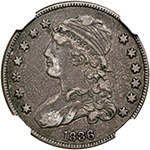 |
1836. NGC graded VF-35. Nice even grey toning.
Estimated Value $120 - 140.
View details and enlarged photos
| Realized
$247 |
Lot 395 |
 |
1836. NGC graded VF-35. Lightly toned.
Estimated Value $120 - 140.
View details and enlarged photos
| Realized
$247 |
Lot 396 |
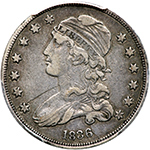 |
1836. PCGS graded VF-30. CAC Approved. Light even toning (PCGS # 5355) .
Estimated Value $110 - 120.
View details and enlarged photos
Check results on similar lots
| Realized
$235 |
Lot 397 |
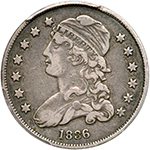 |
1836. PCGS graded VF-30. CAC Approved. Light even toning (PCGS # 5355) .
Estimated Value $110 - 120.
View details and enlarged photos
Check results on similar lots
| Realized
$247 |
|
|